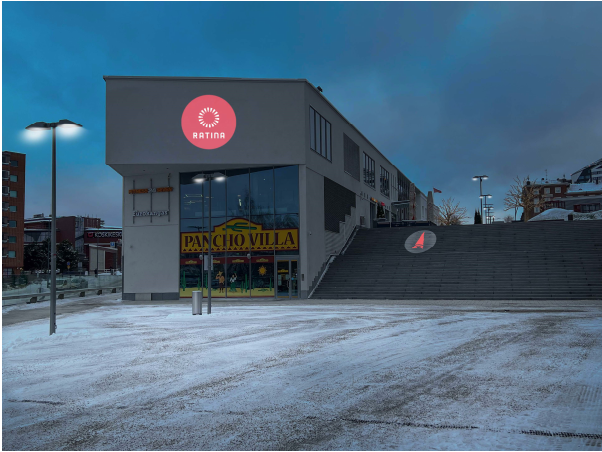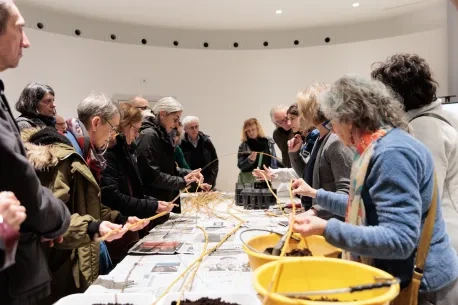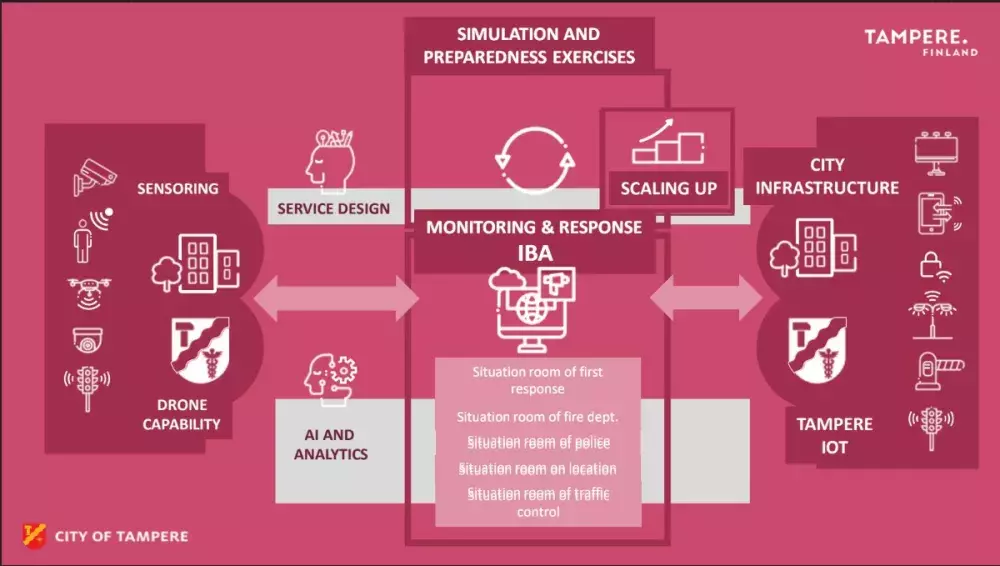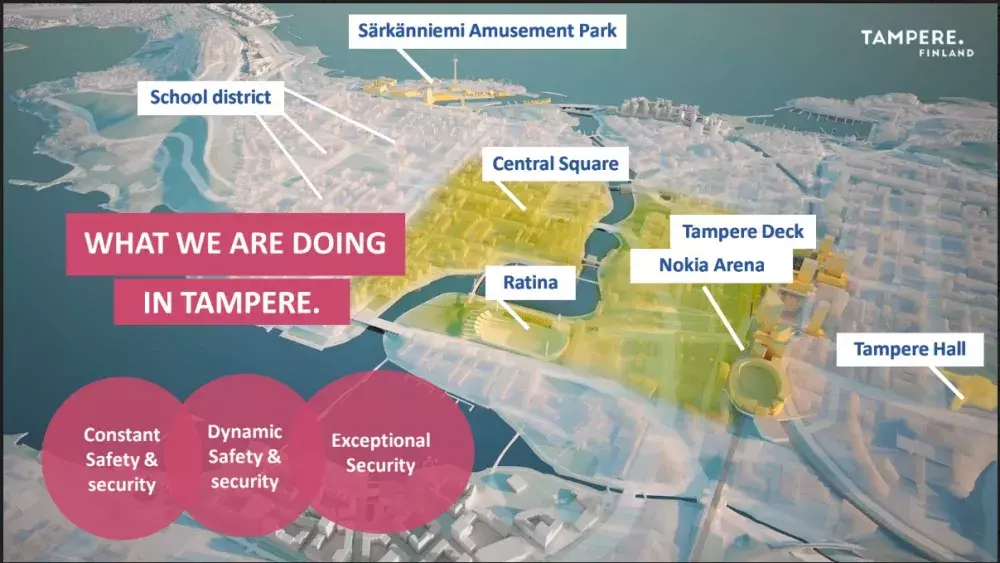Smart Urban Security & Events Resilience (SURE) Journal 2: Increasing safety of public events and building the city’s capacity for long-term resilience planning

SURE as a service for cities and event stakeholders has brought a tangible new approach to large scale event management in the urban context. It offers cities and urban event coordinators new security-oriented Artificial Intelligence tools as well as 'offline' change management guidance towards increasing capacity to plan and predict risk in advance. As such it has tangible Social Return on Investment impact by offering risk mitigation and prediction services, increasing city capacity to quickly manage any risk related occurances and increasing the social dividend to daily public space management services.
SURE works when everything runs smoothly and it has a proven social return to investment (or a resilience dividend) of over 7 million euros for Tampere. This Journal outlines in what ways SURE has developed from a pilot project to a horizontal city-wide tool, showcases the technical innovations and sheds light on the innovation challenges that emerged in the context of the project development.
Summary of key project developments
The SURE program is about urban security and public space management through the lenses of event-management in public spaces.
SURE stands for Smart Urban Security and Event Resilience. By focusing on events taking place in Tampere Central Square, the newly constructed, Nokia Arena and the Tampere Public Stadium ‘Ratina’ the project aims to
- increase cross-sectoral preparedness to threats against public spaces and other urban security risks,
- advance the Artificial Intelligence (AI) technology around public surveillance
- Establish long-term capacity in the city to build urban resilience and
- reduce vulnerabilities in daily life by focusing on preparedness.
The project advances the goals of the European Urban Agenda for improved public space safety and digitisation. In addition, it offers a new perspective on the direct link between urban prosperity, urban tourism and resilience building. Throughout 2021-2022 SURE:
- Has been presented at the Dubai World Expo raising significant interest from development and security stakeholders alike, streamlining its potential uptake beyond the end of the original project lifecycle.
- Has been actively tested in real-life conditions as a key risk management mechanism at the International Hockey Championships co-hosted in the Tampere Nokia Arena in May 2022.
- Has been incorporated formally within the Tampere City administration thus ensuring continuity. SURE will inform the city’s data and foresight agenda while looking to build a new proposition for resilience building as an urban development mechanism in Tampere. SURE is nominated as one of the flagship themes in the new city level strategy called Data-Driven City for Citizens.
The project touches upon three critical urban resilience building dimensions based on two urban resilience roadmaps as developed by the former 100 Resilient Cities program and UNDRR MCR2030 respectively. Below is an overview of developments under each of these dimensions:
- A governance and change-management dimension that in the past 12 months led to the concrete collaboration between security agencies such as the police and the fire-department, several city departments including the city’s Mayor Office, the Urban Development department, the Risk Management Unit and the new Smart City Unit as well as private actors and investors such as the Nokia Arena and event organisers such as the organisers of the International Hockey Championships 2022.
- A technological dimension that has led to the creation of an AI based solution for risk mitigation, crisis-management and events’ management. The SURE platform has at this stage been applied in practice and constitutes part of the back-office security system of the Tampere Nokia Arena. It operates through a set of newly installed cameras, a newly adjusted system of AI that has been trained to ‘read’ and interpret for possible threats at a variety of situations in the public spaces and an integrated platform that feeds into a virtual monitoring/situation room. The technology has been developed by the two leading Finish Tech companies INSTA and NOKIA.
- Increasing city resilience and long-term equitable urban development. The key challenge of SURE is to increase event-related urban security without over-securing sensitive urban areas which may cause the undermining of the citizens’ sense of security. In parallel SURE is touching upon the question of event-policy development and social spatial justice including the free use of public space and accessibility. For example, a large-scale sports event or a concert may bring significant disruption in mobility and transport not only increasing any possible security concerns but also having an adverse effect on residents’ quality of life and access to services. Such considerations have fed into the planning stages for the delivery of the international Hockey Championships (May 2022) and the development of an ultra-local mobility plan which is currently under development and has been co-led by SURE team staff.
The SURE program is about urban security and public space management through the lenses of event-management in public spaces.
SURE stands for Smart Urban Security and Event Resilience. By focusing on events taking place in Tampere Central Square, the newly constructed, Nokia Arena and the Tampere Public Stadium ‘Ratina’ the project aims to
- increase cross-sectoral preparedness to threats against public spaces and other urban security risks,
- advance the Artificial Intelligence (AI) technology around public surveillance
- Establish long-term capacity in the city to build urban resilience and
- reduce vulnerabilities in daily life by focusing on preparedness.
The project advances the goals of the European Urban Agenda for improved public space safety and digitisation. In addition, it offers a new perspective on the direct link between urban prosperity, urban tourism and resilience building. Throughout 2021-2022 SURE:
- Has been presented at the Dubai World Expo raising significant interest from development and security stakeholders alike, streamlining its potential uptake beyond the end of the original project lifecycle.
- Has been actively tested in real-life conditions as a key risk management mechanism at the International Hockey Championships co-hosted in the Tampere Nokia Arena in May 2022.
- Has been incorporated formally within the Tampere City administration thus ensuring continuity. SURE will inform the city’s data and foresight agenda while looking to build a new proposition for resilience building as an urban development mechanism in Tampere. SURE is nominated as one of the flagship themes in the new city level strategy called Data-Driven City for Citizens.
The project touches upon three critical urban resilience building dimensions based on two urban resilience roadmaps as developed by the former 100 Resilient Cities program and UNDRR MCR2030 respectively. Below is an overview of developments under each of these dimensions:
- A governance and change-management dimension that in the past 12 months led to the concrete collaboration between security agencies such as the police and the fire-department, several city departments including the city’s Mayor Office, the Urban Development department, the Risk Management Unit and the new Smart City Unit as well as private actors and investors such as the Nokia Arena and event organisers such as the organisers of the International Hockey Championships 2022.
- A technological dimension that has led to the creation of an AI based solution for risk mitigation, crisis-management and events’ management. The SURE platform has at this stage been applied in practice and constitutes part of the back-office security system of the Tampere Nokia Arena. It operates through a set of newly installed cameras, a newly adjusted system of AI that has been trained to ‘read’ and interpret for possible threats at a variety of situations in the public spaces and an integrated platform that feeds into a virtual monitoring/situation room. The technology has been developed by the two leading Finish Tech companies INSTA and NOKIA.
- Increasing city resilience and long-term equitable urban development. The key challenge of SURE is to increase event-related urban security without over-securing sensitive urban areas which may cause the undermining of the citizens’ sense of security. In parallel SURE is touching upon the question of event-policy development and social spatial justice including the free use of public space and accessibility. For example, a large-scale sports event or a concert may bring significant disruption in mobility and transport not only increasing any possible security concerns but also having an adverse effect on residents’ quality of life and access to services. Such considerations have fed into the planning stages for the delivery of the international Hockey Championships (May 2022) and the development of an ultra-local mobility plan which is currently under development and has been co-led by SURE team staff.
Overview of the UIA management innovation challenges for SURE, Tampere
Planning, leadership and governance are integrated and necessary factors when it comes to developing any kind of security ecosystem (Lacinák, M. & Ristvej, J. (2017). For successful delivery SURE requires access and support from multiple sources of public and private authorities including but not limited to the mayoral leadership, access to key public services, access to the police and other security-related industries and of course, access to data.
In the case of SURE, over the last 12 months the city-team combined leadership development to upscaling where the goal has been to establish:
- SURE as a service that can be integrated within the city administration
- SURE as an exportable product that can be copied and purchased by city governments around the world.
Both goals are naturally very difficult especially when they must be met while the project itself is ongoing. Limitations can be significant in terms of time, human resources as well as political and city budgetary considerations. All these limitations are in fact related to building leadership and support within the city. The key learnings from the case of SURE in Tampere are therefore the following:
- To integrate a new service such as SURE within the city administration firstly, a series of internal meetings and presentations took place where SURE as a service was presented to key staff in the city. The purpose served by these meetings was two-fold. One the one hand to increase the understanding of the service across city-departments and on the other to allow the team to identify under which departments can SURE fit to enable its services.
Secondly, the project managing team ensured that any conversations would be tied up to the mayoral strategic priorities of positioning Tampere as a smart tourism and events destination and that decisions on the future of SURE would also be tied to budgetary cycles. These are three key considerations that are necessary for the introduction of a new service. Following initial approval at the strategic level the step that follows is to describe the specifications of the service, identify the specific resources that are need and create an action-plan that will be approved by the Mayor and city leadership.
To this moment the city has procured new cameras and drones as a direct result of SURE in order to help develop the new system for surveillance geared to risk management and data protection. In addition the city procured smart lights that will be used in strategic locations at the city RATINA STADIUM, the new Tampere NOKIA Arena as well as in key public locations at the city centre. The central idea is a practical application of a tactical urbanism approach which sees smaller practical interventions such as coloured lights as solutioning for improvement of public safety and the perception of safety in public space.
Photo credits: Tampere SURE Team

Within the second year of the project implementation successful cross-departmental working continued to be harder due to the various COVID-19 related restrictions that were active in particular throughout Autumn 2021 and early winter of 2022.
Nevertheless, cross-departmental work was critically linked to
- the early identification of the most appropriate scheme for the continuity of SURE as a service.
- The planning priorities linked to the development of the Tampere Sustainable Mobility Plan and urban development linked to the newly developed areas around the NOKIA arena
- To the Smart City Agenda of Tampere and the development of the new programmatic priorities
Co-creation and participative approach has been an integral part of the project implementation since the beginning. Tampere University has played a big role in creation good public relations between citizens, stakeholders and the project partners. Two residential events were organised in different parts of the city in winter 2022. Sepcifically, the suburbian districts of Hiedanranta and Lielahti are changing rapidly in the coming few years since the city is creating a completely new area for people to live and work in. Therefore, SURE as a service is related to the development process when it comes to ensuring a proactive design from the urban safety and security point of view. The other residential event was organised for people living in vicinity of Nokia Arena. In both events the residents were invited to discuss and share their worries, point out places where they feel unsafe and provide them a chance to suggest other points that may need development soon. The feedback from the events was very encouraging and the citizens felt empowered. Tampere University is planning to continue organising these kind of events in coming months.
Tampere University conducted a survey in Nokia Arena in cooperation with local ice hockey teams Ilves and Tappara. The Arena is a new home for the local ice hockey teams and they wanted to gain more information about how the spectators feel in the Arena. Much of the attention was paid to the visitors´ sense of security and the survey results pointed out to focal points where more attention to safety and security interventions will be required needed. Tappara and Ilves have also indicated that they would wish for the continuation of the cooperation and the plan to conduct a second survey is ongoing.
Monitoring and evaluation in the case of SURE is linked
- to monitoring of the smooth delivery of the project itself
- To the successful reduction of risk and enhanced capacity of risk management
- To the measurement of the social return to investment (SROI) in resilience building
Constant monitoring of the project implementation is undertaken by the project team. Basic follow-up and comparison between the project application and concrete actions is taking place on a daily-basis and so far more is done and achieved than was originally written in the project plan, including but not limited to the project’s transformation to a service and tangible usability in large scale sports events. The city proposes in additional a calculation of the projects Social Return on Investment (SROI), accounting for a diversity of indicators such as:
Decrease in Crime à 3.6 million euro in public savings
Export of Innovation à3.7 million euro returns on investment
Knowledge Sharing à 200.000 euros value created
Overall, the city is estimating a 7-million-euro savings as a result of the adoption of SURE as a service.
SURE has aimed to create a cross-cutting collaboration net between private actors such as the investment agents responsible for the construction of the new Tampere Arena as well as AI developers, urban planning authorities, local, national and European security stakeholders as well as the research and academic community. To do so, the project leads have established direct communication lines with representatives from each of these sectors who are vital partners for the success of the project as well as primary end users.
SURE is primarily a B2B service and as such target beneficiaries of SURE also involve safety and security services such as Fire and Police authorities. The SURE solution is a tool that enables multiple organisations to train together, simulate and share situational awareness with each other. The commitment and support from the organisations are crucial for the deployment of the tool for day-to-day use. The presented business model may not have budgeting requirements for the right to use the service, but nevertheless the organisations need to assign resources and adjust their own process to facilitate use of the SURE solution in their day-to-day operations.
Meetings with authorities and relevant NGOs (i.e., Central Finland Police Department, Tampere Region Rescue Department, First Responders of Pirkanmaa Hospital District and Finnish Red Cross) have been held during November 2021, together with City of Tampere and the SURE technology partners. In these meetings the Minimum Viable Product and the business model were presented, and feedback was requested which pointed to an encouraging future adoption rate of the SURE solution.
Planning and preparation for upscaling started already in the first year of the project delivery and continued throughout the second year. Early considerations for scaling up have now led to
- Identifying the parameters of SURE as a SERVICE and accurately describe the implementation steps for adopting SURE.
- Identifying local and international opportunities where SURE could be communicated and presented. Between September 2021 and June 2022 these opportunities included but where not limited to the Barcelona Expo, the European Urban Security Forum, the UNDRR European Forum for Disaster Risk Reduction, the Dubai World Expo as well as the Tampere Smart Cities Week.
- Building a community of practice based on the collaboration between the three UIA cities working on Urban Security and the involvement of EFUS
- Testing the BETA version of SURE
Collaboration with the UIA Security Cluster cities and the European Union Urban Security Ecosystem (EFUS) has been achieved by the regular organisation of online and offline meetings through the support of the UIA experts and the EFUS. A significant learning in itself as it demonstrates that scalability and internationalisation of a pilot service or project are distinct from development and implementation and require a separate set of skills and support that are often not in fact foreseen at the planning stage of such projects.
In addition, upscaling is directly linked to the challenge of building leadership for urban innovation as well cross-departmental working which in the case of SURE have formed a key triangle of success that helps SURE evolve from a project to an integrated service, an effort that continues in the final year of the project implementation and development.
Concluding remarks and innovations summary. How is SURE moving the needle in the Urban Security Agenda
Throughout the unfolding of the COVID-19 global crisis, the City of Tampere continued working on developing a diversity of mechanisms for the expansion and protection of public life while investing in an array of large-scale urban infrastructure projects that have increased the city’s position as a growing hub of innovation, leisure and sustainability.
Rendering Tampere a safe events destination is part of the city’s larger urban strategy Tampere City Strategy 2030 offering a unique combinatory focus on the future of jobs, technological development and the complicating safety environment.
The UIA project SURE, is a cornerstone of these interventions embedded within the Tampere City Strategy 2030. Having completed its second year of implementation the project has already succeeded in developing a completely new and exportable events security tool which has been tested in real-life circumstances such as the international Ice-Hockey Championships.
Looking forward and considering the day-to-day use of the SURE solution, a good path is now paved for the City of Tampere to make the needed business decisions concerning SURE solution. The SURE solution functionality (MVP) and the prepared business model have been defined and presented to stakeholders (i.e., authorities, NGOs and location representatives). Positive feedback and indication of interest was voiced by all parties.
The activities carried out in the project enabled the creation of a scalable model for implementing similar process in other cities. The scalable model for most parts has been tested during the SURE project, and it can be applied with high confidence level in other cities.
Looking forward, Tampere is investing in new event locations and expanding the existing venues. These will require additional focus and activities relating to urban and event safety and security as Tampere will be hosting considerably bigger events in the future with these event venues and SURE as a service can be expected to continue growing.
Photo credits: Konstantina Karydi

Throughout the unfolding of the COVID-19 global crisis, the City of Tampere continued working on developing a diversity of mechanisms for the expansion and protection of public life while investing in an array of large-scale urban infrastructure projects that have increased the city’s position as a growing hub of innovation, leisure and sustainability.
Rendering Tampere a safe events destination is part of the city’s larger urban strategy Tampere City Strategy 2030 offering a unique combinatory focus on the future of jobs, technological development and the complicating safety environment.
The UIA project SURE, is a cornerstone of these interventions embedded within the Tampere City Strategy 2030. Having completed its second year of implementation the project has already succeeded in developing a completely new and exportable events security tool which has been tested in real-life circumstances such as the international Ice-Hockey Championships.
Looking forward and considering the day-to-day use of the SURE solution, a good path is now paved for the City of Tampere to make the needed business decisions concerning SURE solution. The SURE solution functionality (MVP) and the prepared business model have been defined and presented to stakeholders (i.e., authorities, NGOs and location representatives). Positive feedback and indication of interest was voiced by all parties.
The activities carried out in the project enabled the creation of a scalable model for implementing similar process in other cities. The scalable model for most parts has been tested during the SURE project, and it can be applied with high confidence level in other cities.
Looking forward, Tampere is investing in new event locations and expanding the existing venues. These will require additional focus and activities relating to urban and event safety and security as Tampere will be hosting considerably bigger events in the future with these event venues and SURE as a service can be expected to continue growing.
Photo credits: Konstantina Karydi

About this resource
The Urban Innovative Actions (UIA) is a European Union initiative that provided funding to urban areas across Europe to test new and unproven solutions to urban challenges. The initiative had a total ERDF budget of €372 million for 2014-2020.
Similar content






